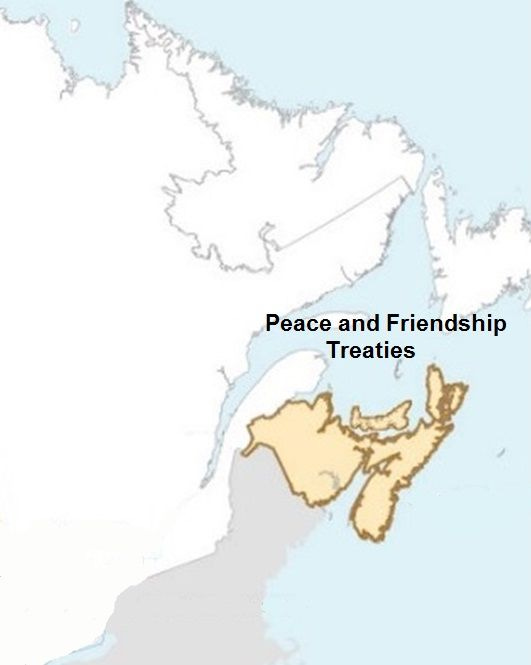The 1725 Treaty of Peace and Friendship
Introduction
The 1725 Treaty of Peace and Friendship was one of the earliest agreements between the British Crown and Tribes or Nations in North America. Signed between British representatives and the Wabanaki Confederacy (which included the Mi'kmaq, Maliseet, and Passamaquoddy peoples), the treaty aimed to end hostilities and establish peaceful relations. Unlike later treaties that focused on land cession, this agreement centered around trade, diplomacy, and mutual recognition of rights.
Historical Context
By the early 18th century, tensions between the British and Wabanaki Confederacy were rising due to colonial expansion into Tribal or National territories in present-day Nova Scotia, New Brunswick, and parts of Quebec and Maine. The British sought peace to solidify their claims, while Tribes or Nations aimed to secure their hunting, fishing, and territorial rights.
The treaty was first signed in Boston on December 15, 1725, with ratifications taking place in Nova Scotia in 1726, ensuring participation from additional Wabanaki leaders.
Full Text of the Treaty (1725)
We, the undersigned, being delegated by our respective tribes and instructed therein, do agree, acknowledge, and declare as follows:
That we, for ourselves and our heirs, will forever cease and desist from all acts of hostility and war against His Majesty's subjects, settling within the limits of His Majesty's territories and dominions.
That we acknowledge His Majesty King George as our lawful sovereign and submit ourselves to his government and protection.
That we do, in behalf of ourselves and our heirs, confirm and renew all former treaties and agreements with the English.
That we will not molest, hinder, or interfere with any English settlements or fortifications already made or to be made within the territory of His Majesty’s dominions.
That any disputes between English settlers and our people shall be fairly resolved, and we shall abide by the laws and justice of His Majesty’s government.
That we reserve to ourselves the right to hunt, fish, and use the lands as we have formerly done within His Majesty’s dominions, without disturbance.
That in return for our peace and good conduct, His Majesty's subjects shall not molest or disturb our people in their customary hunting and fishing grounds.
That the English shall maintain trade with us at fair and equal terms and that any grievances shall be settled through proper negotiations and not by force.
That we shall return any English captives and, in turn, expect fair treatment and protection under His Majesty’s government.
In witness whereof, we have set our marks and seals in the presence of witnesses, this fifteenth day of December, in the Year of Our Lord 1725.
Key Takeaways
This treaty did not involve land cession; instead, it focused on peace, trade, and maintaining Tribal or National rights to hunt and fish.
It acknowledged Tribal or National sovereignty while also requiring them to recognize King George as their ruler.
It established a framework for resolving disputes but lacked clear enforcement mechanisms, leading to later conflicts.
The treaty was ratified again in 1726 in Nova Scotia, expanding its recognition among Wabanaki leaders.
Did Tribal or National Leaders Understand British Sovereignty?
One of the most debated clauses in this treaty is the requirement that Tribal or National leaders "acknowledge His Majesty King George as our lawful sovereign and submit ourselves to his government and protection."
Different Interpretations of Sovereignty: Tribes or Nations traditionally saw treaties as agreements between equals, not as acts of surrender. Their governance was decentralized, and alliances were built on reciprocity, not absolute rule.
Language and Translation Issues: The treaty was written in English, and the oral discussions likely emphasized peace and trade rather than the European legal concept of submission to a monarch.
No Direct Experience of British Governance: At the time, it is unlikely that Wabanaki leaders had firsthand exposure to the British legal system. While some Tribal or National delegations visited England later, in 1710, the "Four Indian Kings" from the Haudenosaunee Confederacy met Queen Anne, but this did not directly involve the Wabanaki.
Treaty Misinterpretation: Tribes or Nations may have viewed this clause as an agreement for peaceful relations and mutual benefit rather than permanent subjugation under British rule.
This discrepancy in interpretation has contributed to long-standing legal disputes over Tribal or National rights, sovereignty, and the true intent of early treaties.
Lasting Impact
The principles of this treaty influenced later Peace and Friendship Treaties.
Many Tribal or National groups argue that its recognition of hunting and fishing rights remains legally binding today.
The treaty is often cited in modern land rights disputes and court cases.
Next in the Series
The next post will cover the 1752 Treaty of Peace and Friendship, which expanded on this agreement and further clarified Tribal or National rights.
This document provides a historical and legal reference for those exploring the early foundations of Tribal or National-Crown relations in Canada.





